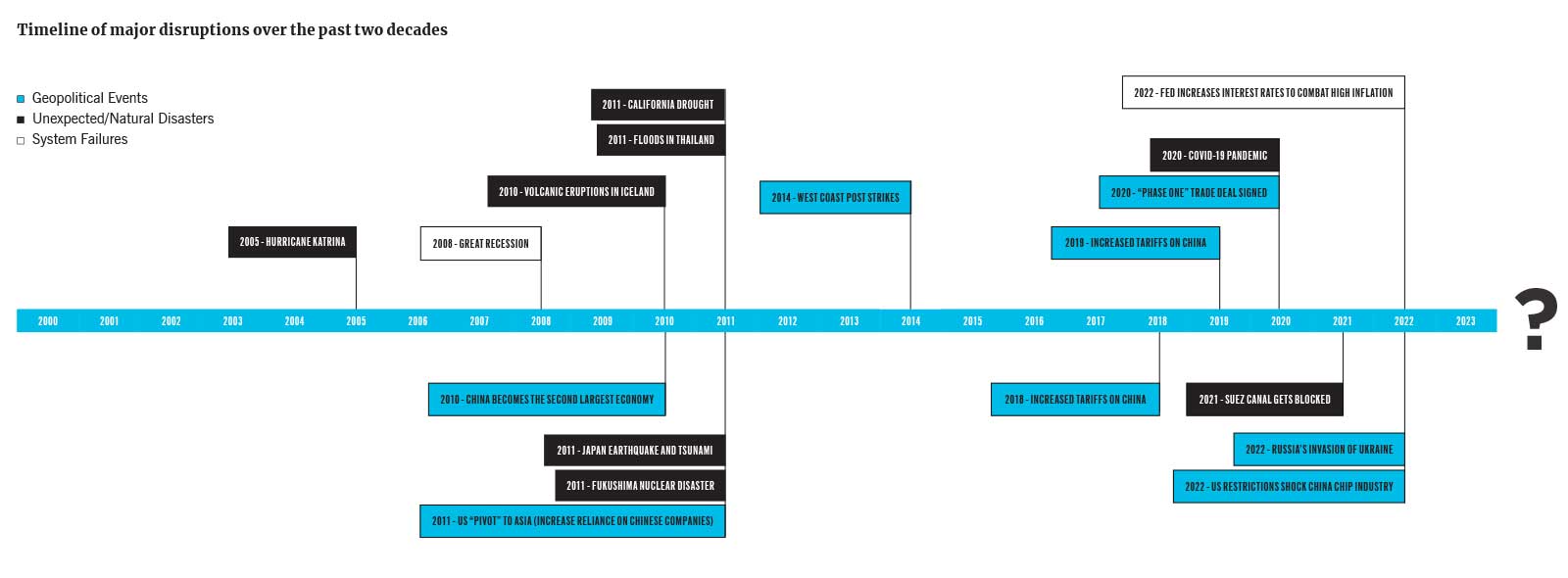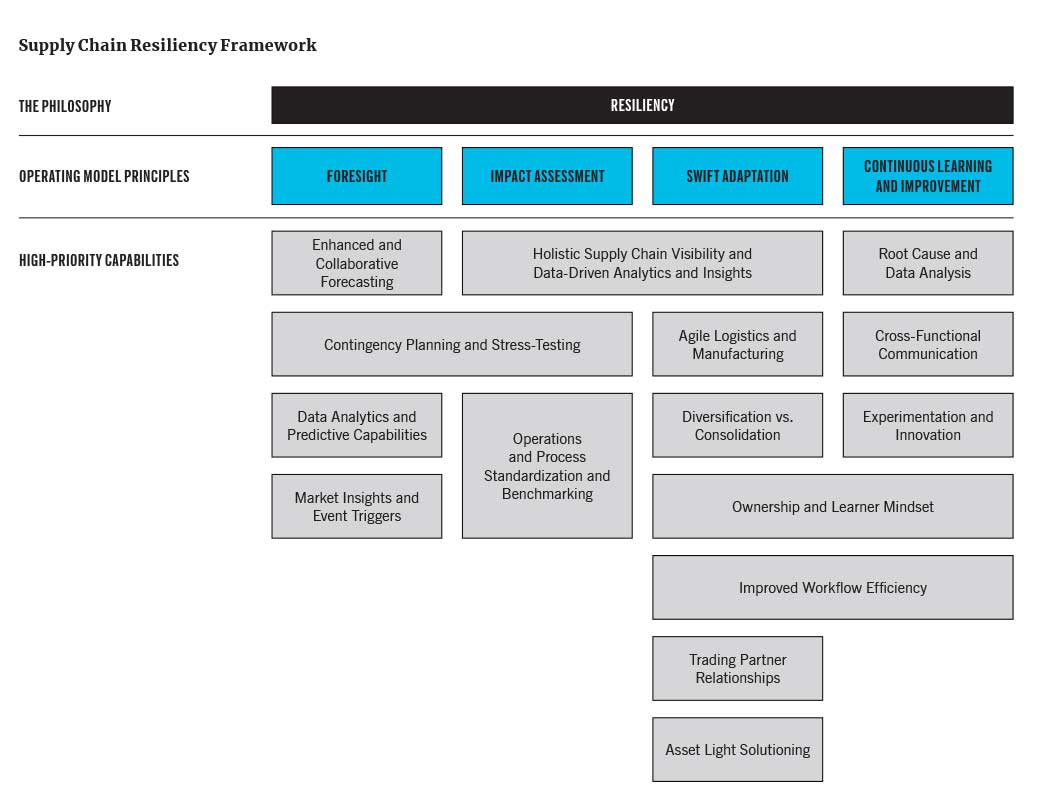The concept of supply chain resiliency has become increasingly significant in recent years, particularly in the face of disruptive events caused by the pandemic. However, the need for an adaptable strategy in times of disruption will continue to be relevant beyond the current circumstances. This article explores why companies should be thinking about resiliency and what it means to have a resilient supply chain network.
A View on Supply Chain Resiliency
The term “supply chain resiliency” has gained much popularity during the past few years, largely driven by foundational disruptions caused by the pandemic. But this is not going to be the last time every credible publisher on Wall Street talks about the need for having an “adaptable strategy in times of disruption.” Economic disruptions are usually followed by investments in corrective solutions in the aftermath, but very few manage to swiftly climb the ladder of adversity and succeed. The ability to leverage history to make adaptability a key characteristic of one’s business strategy and operation differentiates the resilient from the fragile.
So, how often do supply chain disruptions that define the fate of an enterprise actually happen? The answer: all the time. Supply chains, which encompass the complex network of processes, people, and resources involved in the production and distribution of goods and services, are vulnerable to various risks and disruptions. These can include natural disasters, geopolitical tensions, trade disputes, cyberattacks, regulatory changes, and unexpected black swan events like a global pandemic. Such disruptions can have severe consequences on businesses and economies. The following visual displays a timeline of key disruptions that occurred over the past 20 years and makes the case that global disruptions are very common and do not follow a trend.

What Is Supply Chain Resiliency?
It’s important to have a foundational understanding of resiliency before you align your entire company and pivot key strategies. Many companies mistakenly talk and think about resiliency as a temporary Band-Aid solution. It is not something that can be switched on and off like a light switch. It requires discipline and a commitment to the concept. So, what is resiliency when we strip away all the hype and commentary we’ve heard over the past few years? It is a philosophy, a way of thinking and behaving.
To help make sense of and navigate this philosophy, we have developed a simple structure that consists of three levels:
- The Philosophy
- Operating Model Principles
- High-Priority Capabilities
As a business leader, this is a helpful framework to adopt into direction-setting exercises to ensure that your teams are constantly looking around the corner, assessing scenarios and their impact, adapting and selectively investing in the things that matter most, and learning and quickly driving this into the mental muscle of the organization.
The Philosophy
Resiliency as a philosophy centers an organization on adapting and thriving in times of adversity or challenges. It is a creativity-backed approach to look at situations the way they are, accepting the potential occurrence of events with varying degrees of probabilities, and implementing adaptability as a North Star in one’s thoughts, attitude, beliefs, and principles.
Operating Model Principles and High-Priority Capabilities
The four operating model principles act as guide rails for organizations when thinking about resiliency. Foresight, Impact Assessment, Swift Adaptation, and Continuous Learning & Improvement all tie into each other and flow chronologically to ensure resiliency. Foresight enables organizations to anticipate and predict the probabilities of future events, which sets the stage for proactive planning. Predictive capabilities intricately weave into Impact Assessment, where the magnitude and implications of a given disruption are carefully recorded and analyzed. A concrete understanding of potential disruptions and their impact determines the prescription of relevant strategies. Swift Adaptation focuses on the timing and execution of supply chain strategies, leveraging knowledge from Foresight and Impact Assessment. Continuous Learning and Improvement involves post-disruption analysis, which is the last step that completes the cycle by absorbing insights from every stage to improve the organization’s knowledge base.
The following deep dive provides additional detail on each of the four operating model principles, and how high-priority capabilities can assist in execution.

1. Foresight
Having a crystal ball and looking into the future is always exciting. Now, that might sound far from reality, but leveraging the data that produces the right insights can get an organization very close to having its own in-house future-predicting crystal ball. Foresight allows for proactivity rather than reactivity. It encompasses data capture, analytics, and enhanced predictive capabilities, which enable early detection of potential risks and disruptions — helping organizations effectively model different scenarios and assess implications. While data-informed predictive capabilities are key to Foresight, cross-functional communication encourages knowledge sharing, visibility, and collaborative decision-making — a critical piece in aligning teams and functions.
2. Impact Assessment
A baseline of operations and performance serves as the “one source of truth” when understanding the impact of disruptions on a supply chain. Impact Assessment involves meticulous recording and real-time evaluation of how key performance indicators move in the presence of disruptions and stress. Impact Assessment enables organizations to discern between typical operations, and those altered by stress, thereby highlighting impacts that matter the most and prompting organizations to take actions to address the realized stressor.
3. Swift Adaptation
Supply chains are complex systems that require care and nurturing, and any disorder across the different nodes can create a “bullwhip effect” up and down the value stream. Hence, it is important that the response to disruptions is fast and accurate but also thoughtful and deliberate. The third operating model principle, which focuses on solution design and execution, implements key components of resiliency — speed and adaptation with purpose. Adaptability focuses on the flexibility of a supply chain to adjust its operations, strategies, and partnerships, while Swiftness prioritizes agility.
Embracing Swift Adaptation directs supply chains to develop capabilities that prioritize resiliency. Capabilities like Agile Logistics, Distribution, and Manufacturing enable flexible operations that respond quickly to meet market demand. Diversification vs. Consolidation capabilities, such as nearshoring, offshoring, and multisource, reduce dependencies. Building strong Trading Partner Relationships encourages collaboration and joint problem-solving with vendors. Swift Adaptation also focuses on developing internal capabilities that instill an Ownership Mindset across the organization, allowing a complex relationship of teams to work toward a common and directed outcome in times of disruption.
4. Continuous Learning and Improvement
The fourth principle brings together the resiliency framework by capturing knowledge, data, and experience of a supply chain’s journey through a disruption, helping the organization mature and paving a well-informed and constructive path for the next generation of disruptions and risk events. Continuous Learning and Improvement focus on developing capabilities like Root Cause Analysis and Experimentation and Innovation — which drives the practice of “looking in the rearview mirror” and understanding the what, when, how, and why of the disruptive event. It allows an organization to understand the impact and prioritize and develop creative solutions for the future. This final principle helps with the forward evolution of a supply chain network into a resilient and mature ecosystem.
By integrating these principles, supply chains can effectively withstand and recover from disruptions and turn vulnerabilities into strengths. Having a heightened awareness of the changing landscape, knowing what capabilities to invest in when it matters most, and being relentless in execution differentiates industry-leading companies from the rest.
Case Studies
History shows that companies that have adopted resiliency as their guiding principle and invested in capabilities have seen great returns on invested time and capital. Following are two case studies of Fortune 50 companies that have leveraged resiliency to gain a competitive advantage in the marketplace during global disruptions.

P&G navigates workforce shortages and supply disruptions through its resiliency-focused Integrated Workforce System (IWS).
Years before the pandemic, P&G placed an emphasis on resiliency and has been honing its Integrated Workforce System (IWS) and digital tools. IWS is a proprietary way of improving manufacturing reliability, reducing costs, and enhancing productivity. When simplified, IWS encourages each employee on the manufacturing floor to take ownership. Employees are encouraged to find potential manufacturing roadblocks, identify root causes, propose innovative solutions, and execute them. By embracing resiliency, P&G incorporated contingency plans in case of crisis and invested resources to develop and stress-test backup plans.
With all employees embracing an ownership mindset and P&G’s technological capabilities providing supply chain visibility for leadership, the firm was producing about 90 percent of its throughput with only about 50 percent of staffing present on the manufacturing floor during the pandemic.

Toyota’s experience in navigating the 2011 Japan earthquake and tsunami helped the firm predict and respond to potential production bottlenecks during the COVID-19 pandemic.
The 2011 earthquake and tsunami, which created a high shortage of parts mainly due to the destruction of multiple production plants in Japan, forced Toyota to take a strategic approach to inventory planning by sizing inventory levels to meet changing demand; assessing the criticality of parts; sizing safety stock levels for potential disruptions; and tracking and managing lead times. In response, the firm started to diversify production to other regions instead of relying only on its home territory of Japan, worked closely with suppliers to provide support where needed, and started trusting suppliers as strategic partners instead of looking at them as distant entities.
The evolution of the Toyota Production System (an integrated socio-technical system focusing on efficiency, quality, and continuous improvement) has allowed Toyota to be resilient through the semiconductor chip shortage during the COVID-19 pandemic. Through their experience rebuilding the Renesas semiconductor manufacturing facility in Naka, Japan, after the 2011 tsunami, Toyota realized the importance of these chips in their auto-manufacturing and production process and started to carry higher levels of semiconductor chips in its inventory, allowing the firm to navigate one of the biggest bottlenecks during the pandemic, creating huge competitive advantage.
Conclusion
In an ever-changing business landscape, disruption has become the new normal, and companies must view it as an opportunity rather than a threat. The world as we know it is quickly evolving, and organizations that choose to thrive should constantly reevaluate their supply chain’s maturity and implement the principles and practices of resiliency to reduce exposure and enable faster recovery. By adopting a resilient approach and holding teams accountable to it, organizations can navigate turbulence more effectively, minimize the impact on their operations, and maximize growth and efficiency.
Sources:
- https://mitsloan.mit.edu/ideas-made-to-matter/procter-gambles-ceo-navigating-rapid-change
- https://www.forbes.com/sites/garydrenik/2023/03/23/why-nearshoring-is-closer-than-ever-how-mexico-is-becoming-the-next-big-thing-in-global-markets/?sh=56d1dd7e354b
- https://hbr.org/2022/11/what-really-makes-toyotas-production-systemresilient#:~:text=The%20rapid%20problem%2Dsolving%20drives,also%20learns%20their%20production%20processes
- https://www.everycrsreport.com/reports/R41831.html
- Procter & Gamble’s Futuristic Control Tower Environment (forbes.com)
- https://hbr.org/2022/03/are-the-risks-of-global-supply-chains-starting-to-outweigh-the-rewards
- https://hbr.org/2021/09/a-simpler-way-to-modernize-your-supply-chain
- https://hbr.org/2007/09/are-you-the-weakest-link-in-your-companys-supply-chain
